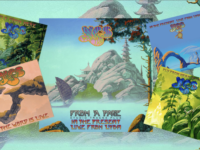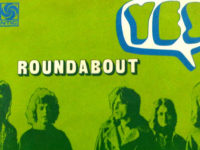Which other bands give us as many opportunities to ponder “what if” as Yes do? It could be argued that we are in the very fortunate position of actually knowing the answers to a couple of these questions, however. In relation to 2011’s Fly From Here, they could be as follows:
What if Fly From Here had been recorded by the same line-up as 1980’s Drama? What if Oliver Wakeman had finished off his writing and performing contributions to the Yes album which appeared immediately after his keyboard tenure in the band?
Trevor Horn famously (and somewhat controversially) removed original singer Benoit David’s contributions and re-recorded the lead vocals. That completed a new version which is, at least in its lineup, sort of like Drama II. Dubbed Fly From Here: Return Trip, the reworked project was issued in 2018 to coincide with Yes’ 50th anniversary, complete with the addition of Steve Howe’s “Don’t Take No for an Answer” and a new Roger Dean cover, complementing the original artwork.
Perhaps even more exciting was the sudden and unexpected announcement in 2019 that three of the songs which the band were working on in 2010 had been finished off by Oliver Wakeman and released in a package along with a Wakeman/David song called “The Gift of Love” and the previously released concert recording, In The Present: Live From Lyon.
So, in the end, this period produced some highly entertaining and quite diverse Yes music but let’s get back to the so-called “Fly From Here Suite,” which opens the album of the same name.
It’s in six sections – “Overture” and then parts I-V labelled “We Can Fly,” “Sad Night at the Airfield,” “Madman at the Screens,” “Bumpy Ride” and “We Can Fly Reprise.” In total, the piece is almost 25 minutes long, and it’s a sign of real confidence that Yes were prepared to create something on this scale. Perhaps some of that confidence sprung from the re-union of the band with Drama-era members Trevor Horn (as producer) and Geoff Downes (who took over from Oliver Wakeman on keyboards), both of whom were formerly with the Buggles.
The suite is based on a Horn and Downes demo from their pre-Drama days which saw the light of day on the 2020 re-issue of the Buggles’ Adventures in Modern Recording, only a short time before Fly From Here. There are also a couple of recordings of the Drama line-up playing the original song live in 1980, one of which appeared on 2005’s The Word Is Live, the fabulous Yes box set.
Whether you think this is a proper Yes epic (like Chris Squire did) or not, there’s no denying that it is a remarkable feat to expand the song which was originally in two parts into the “Fly From Here Suite.”
The atmospheric “Overture” section starts with Downes’ piano sound steeped in reverb and seemingly in the distance. The pattern is repeated more clearly and then again, but this time with the rest of the instrumentalists adding short, spiky, loud chords. The scene is set for the exploration of the themes in the later parts and, in this way, it is indeed a real overture – like the opening music to an opera before the main action starts.
The sound is brilliantly produced and it’s a delight to have a real keyboard player back after the orchestral adaptation of the Yes approach on 2001’s Magnification. Geoff Downes’ multi-layered, elaborate turn helps the piece to spin on quickly and very satisfyingly into “Part 1: We Can Fly.”
“We Can Fly” is one of the tracks on which Oliver Wakeman adds some additional keyboards, although picking out which parts are him is impossible, certainly for me. The opening soundscape conjures up an airfield with the gentle noise of aircraft engines, before Downes leads off with a piano figure.
Then we get our first taste of Benoit David’s lead vocals. Even though he was only with the band for a short time, it’s great to have this performance from him. He sounds assured and sings with a beautiful tone – particularly in the high sections. Trevor Horn has pointed out how much work he had to put in to help Benoit sing in the studio, but isn’t the end product more important?
It’s also fantastic to hear Steve Howe’s soaring electric guitar in the background, symbolizing, perhaps, aircraft in the distance. Chris Squire adds very typical, rhythmic bass patterns. There are lovely creative touches added in how the pulse is suspended, and then the verse swings in again – this time supported by a full drum rhythm and band accompaniment.
The music swells towards the “We Can Fly” chorus, which is full of word painting with the shape of the vocal line climbing and falling as if the music were looping the loop in the air. It’s clearly a pop version of Yes’ music, but the way in which the feel of the chorus fits with the verse is exquisitely handled to produce a spine-tingling sensation.
Howe is featured again at the start of “Sad Night at the Airfield,” with lovely acoustic sounds against a quiet maracas and keyboard accompaniment. He foreshadows the vocal line which David brings in next. This all serves as an introduction to a big, cinematic entry by the rest of Yes for a chorus section.
It’s a sad song with some interesting contrasts in the texture featuring long vocal lines set against some more active drum patterns. Quiet passages are also used for contrast to the cinematic sections and Squire has a couple of nicely judged solos, which accentuate the feel. “Sad Night at the Airfield” is certainly a second part to the suite, but retains enough of the feeling, lyrical and musical content of the first part to make it feel more like a variation on the theme than a separate track. In fact, I think this is handled remarkably well throughout the suite, with a lot of consistency adding to the overall impression of a homogeneous piece rather than sections bolted together.
Fantastic passages of Steve Howe soloing bring us to “Part III: Madman at the Screens.” Geoff Downes’ distant piano starts us off again with echoes of the opening of the overture, reminding us how effective that introduction is in tying all the movements of the suite together: Most of the themes are already at least partially familiar – which is, of course, precisely the purpose of overtures in opera and elsewhere.
The initial short phrases of the vocal line on “Madman at the Screens” are an interesting treatment. It gives the “sailor, beware” section a good, contrasting feel. The lyrics here, like elsewhere, are categorically not in the traditional Anderson-Yes style. They are, at times, slightly jarring but generally don’t detract from the music too much for me.
The Yes choir blends really well with David, and he certainly sounds very convincing and assured on “Madman at the Screens,” which is perhaps surprising as this is his first large-scale recording. It’s engaging and compelling music with touches of the classic Yes sound like Downes’ use of a Hammond organ blended with other overtones of the Drama-era as the track ends with a reprise of the “sailor, beware” material.
The next part, “Bumpy Ride,” consists initially of a couple of alternating rhythmical patterns in differing time signatures, obviously meant to portray the bumps in this particular ride. It’s a comparatively short section, which Yes plays in typically tight formation, reminding us perhaps of a stunt plane team in synchronicity. The rising triple-time sequence is particularly effective, with the bass part once again perfectly matching and complementing the keyboard and lead guitar parts in the way only Chris Squire can manage.
The material, particularly with Geoff Downes’ choices of keyboard voice, veers dangerously close to a parody of the Drama-era sound but just manages to save itself, primarily due to the technical mastery of the individual players. Half way through the short “Bumpy Ride,” there is a dreamy passage of vocals, providing a good contrast and then the bumpy ride returns to finish and usher in the “Fly From Here: Reprise.”
This is a truly wonderful moment of Yes magic: The “Fly From Here” theme has been away for just long enough for the listener to forget about it, then it blasts back in a beautifully handled transition. It’s a very simple device but handled in a superb fashion by the band and producer extraordinaire, Trevor Horn. It’s like returning home as Benoit David sings that huge, catchy chorus once again. The play out is great as well – with Squire’s repeatedly climbing bass line ramping up the tension before “Fly From Here: Reprise” finally dies away.
For me, the “Fly From Here Suite” is brilliant and utterly convincing as a new, solid Yes sound. A modern (for 2011) Yes epic, which combines the best aspects of their more recent incarnations with new ingredients and classic methodology. Some may think it’s a pale reflection of past glories but if you do, I encourage you to listen again, without preconceptions – without thinking who the singer is, without wishing it was Rick Wakeman on keyboards (or Igor Khoroshev, or Oliver) and just enjoy the fabulous music-making.
When Fly From Here was released, I remember my excitement that Yes was still capable of transcending so many barriers which would have stopped other bands. Fast forward to 2020, and we’ve had numerous subsequent “what if” moments – and I’m in no doubt there are many more to come.
- Yes, “Mystery Tour” from ‘The Quest’ (2021): YESterdays - November 23, 2021
- Yes, “Minus the Man” from ‘The Quest’ (2021): YESterdays - October 5, 2021
- Yes, “Subway Walls” from ‘Heaven and Earth’ (2014): YESterdays - December 8, 2020




